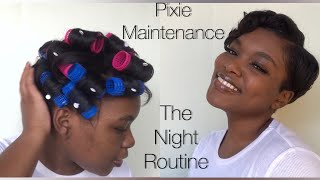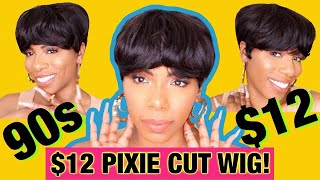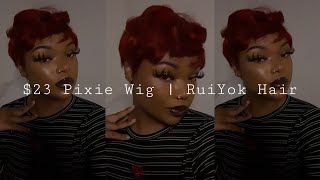Part One - Undercut Pixie Haircut Tutorial - Tips For A Better Blend With The Top
Cutting an undercut pixie haircut can often leave too strong of a disconnection of a mohawk kind of effect. Discover a unique approach on how to set up the underneath to create a better flow with the top section. Part Two on how to complete the top is coming next week so stay tuned.
Want to dive deeper into other undercutting techniques? Check out our blog:
https://www.samvilla.com/blog/razor-un...
Want more education? Make sure to subscribe: http://bit.ly/2mCNIib
Click that bell on the screen to make sure notifications are on!
To learn more about all of our styling tools, discover upcoming events, or to book one of our artists for events or in-salon education visit us:
Get Social with us!
Instagram - https://bit.ly/2Bq94bt
Facebook - https://bit.ly/2PKuAAi
Pinterest - https://bit.ly/2DytLDo
Linkedin - https://bit.ly/2PGdfZo
Twitter - https://bit.ly/2BnqG7Q
What'S up everybody, this is jesse linares with the sanvia art team. You know we see and teach a lot about undercut pixies out there and there's one thing that we bump into a lot that we wanted to address specifically today, and that is when sometimes we might take our undercut just a little bit too high. Like all the way up to the vertical transition, which can leave us a little bit bare under there, sometimes leaving our pixies almost like mohawks on top of the head. So we're going to explore today how to create some transitional areas between the very short and the much longer that are going to give us weight and volume that we need that's crucial for our silhouette. So we'll we'll be taking you through how we can create these safety nets that also leave the undercut in place, but that create a nice soft transitional area to carry us on top all right. So we're sectioned off and we're ready to begin our undercut. We'Re going to go after this shear over column, but we're going to use our 6 inch reversible blending shear for it. The advantage of this is that it's going to give me a much softer result, as i work my way through, because it doesn't take all the hair off at one time, so a little major landscaping here and i'll press the comb tight against the head. As i work my way up as i get close to the other sections i'll, just let the comb glide over them, which will prevent me from cutting into the sections that i have isolated, i won't spend a lot of time discussing this with you. I know most of us have done shear over comb before the important thing to remember is that we are using a different tool to achieve a much softer. End result all right. So that brings us to here. We'Ve disappeared this underneath section using shear over comb in our reversible blender for a nice soft result and now we're ready to deal with our transitional pieces. That'Ll. Take us from this bare wood, all the way up to the length that we're going to be retaining. On top, so the first thing i'm going to drop are these little transition sections that live right in front of the temple right there. This is going to be the grace that allows us to transition a long fringe into something that lives around the face. I'M going to come after this with my artist series slide, cutting sheer what i love about this is. It allows me to move through the interior and create nice easy transitions. As i work my way out, the shear is actually designed to start to push the hair as it reaches the end of the shear, and it gives me a really nice buttery result just setting up a little bit of length right there that i can look at And begin to pre-visualize what this is going to look like when i'm done we'll take our next transitional section and drop it down we're going to switch over to our reversible blender once again, because what we want this to happen for us right here is that it's Going to give us the width that we need that way, the head doesn't round up into the undercut section that way it will create narrowness on top unless we have these transitional pieces right there to keep that weight that we need through the temple area. So, as i elevate this up, we'll just take it straight out from the head and what i'm looking for is for something that's going to end just on top of the ear right there and just bump right there. So i'll measure that length - and we can make our cut - looks like about two and a half three inches, so we're going to place our teeth on top, so we can effectively cut as a shear and as i'm cutting i'm going to just pull away from it. A little bit which will even diffuse those ends a little bit more. I can press that down now and take a look at what's happening, working its way right above the ear and i'm going to travel back and continue. My finger rotation or position relative to the section should be parallel. So, as i bring this around, i want to make sure that i'm not staying totally horizontal that i'm starting to follow the line. That'S scribed by the line that we made at the vertical transition taking us through the so-called parietal ridge. So i'll have a slight diagonal back feeling to this, as i make my next cut and then draw away from it to add a little more softness to those ends. So now i'm getting this nice shape that carves around the ear taking us back into the crown area. When i used to do these undercut pixies, we would take it all the way up to here. You know we would end up just invading that crown, and what i would discover, unfortunately, is that it would lay a little too flat back there, and sometimes i felt like i wasn't creating compensatory volume here in the crown to balance out the jaw, and it can Be very unflattering in your silhouette, so for the next section, as i get above the center line, i'm going to elevate up straight out 90 degrees from that area, and then i'm also going to make a slight adjustment in my finger angle. That allows me to build just a little bit more weight or like even a little point as i get to the center back. Looking for my previously cut section as a guide - and i can take that cut missed one little bit so now you can see how that is. Building a nice volume, that's going to lay right on top of that dead wood and give us that volume we need in the crown i'm just going to switch over to the other side and continue just the same as we did before right here and drop this Down the first piece that i'm looking for is that transition right in the temple in front of the ear, giving myself a little bit of softness around the cheeks. That will prevent my undercut pixie from looking a little too edgy a little too rigid. Unless that's what she wanted, switching over to my slide, cutting shear once again and just working my way down and through, and this is truly to taste whatever you feel like - should be left there and don't feel compelled to make both sides match. If one side looks good on that side of the face, make the other side look good on that side of the face, dropping down my transition section, just a little bit of moisture there to stay consistent and now we're going to elevate this, and we were looking For about two and a half three inches that happen right there, we want this to land, just above the ear teeth. On top once again for cutting hair and i'll chase my hand just a little bit to add just a little bit more softness to those ends. We continue our way back, making sure that our finger position or rotation follows the section line so as we're dipping down into the crown. So our finger angle should as well go and finally competing the final piece. We have a guide from where we left off at center back and here's where we are at the horizontal transition at the corner. All i have to do is connect these two lines now awesome. So what we love about this is that it's giving us the transition that we need to build us into the top section, which is going to be a lot longer. So what we're going to do now is just blow dry, these into shape, make sure that they have a good appearance before we move up top, so we've completed our transitional areas and we're just going to detail them out a little bit using our invisablend. This is a slide cutting blending, sheer that any place where these little transitions aren't sitting just snugly. I can go in and just detail that out. I see this little spot right here. That'S just a little bit heavy, so we're going to set the still blade on the skin and just slide our way through until that softens up and lays a little bit nicer i'll. Be careful not to go too close to the scalp with this, because i don't want to create anybody. That'S going to pop up later and say hello and i'm just going to work my way around the head, making sure that these places sit together very nicely working with the grain of the hair. What'S great about the transitions that we've created is that they provide us that little bit of weight and volume that we're going to need through here to help transition us into the crown sometimes like i said earlier, if we get too aggressive back here in the back Of the head and take this too high, it leaves too abrupt of a transition between the top area, which will be longer and the bottom area, which is already very short just detailing this. Until i get the results, i'm looking for and like we mentioned earlier, we don't have to feel compelled to make each side's matchy-matchy as long as each one sits pretty there. It is so these transitions are giving us the weight and volume we need to take ourselves into the top. So definitely think about these transitional effects when working with your undercut pixies or any aggressive haircut. That goes from very short to very long, doesn't matter, male or female, think about these areas and how they help to support the silhouette of the haircut, because if we had this too short right there, that would definitely be a little bit too flat, so use them In your world of hair cutting, and let us know what you think, i'm jesse linares with the sandvia art team, foreign





Comments
Roxie Quin: His instructions are great. The vocabulary he is using his so easy to understand. You can close your eyes and visualize everything his saying. Amazing description. Great video! Amazing cut!
Hannah Jade: Your style of teaching is phenomenal love your work, ty for sharing! You have a blessed day man!
Svetlana Striganov: Jesse, i love the way you explain and handle the transition!!! I am going watch it again today.. :)
K. Campbell: Hey Sammy, this is your old neighbor Kelli Campbell, Lilly Nunley’s granddaughter. How are you!??? I would love to see you! I’ve been trying to get this cut for 20 years. I’ve given up on finding someone in Arkansas to do it. . While watching your video, I had a revelation. Could I just buy this wig??? . Great job and great videos!
Melissa Martin: You’re the Bob Ross of hair cutting
Lilia Lisa: very different from everyone else, very cool
Judith Llewellyn: Oh i wish you could cut my hair. I just can't get a stylist to give me the correct cut for my thick hair. Last girl gave me blunt edges, as if she places a bowl on my head and cut around it.
Tanya Morris: Great Work on that cut
Hala Kh: Great
Fernanda Andre: When are you posting the second video ?
Andrea Johnston: Great video my friend
Fernanda Andre: I will have to wait a week !!!!!!???????
Najla Ahmed: Jesse linare ❤️❤️❤️✂️
sophie larabie: Good boy Jessie
Andrea Johnston: Ok